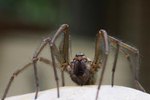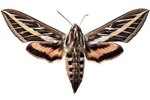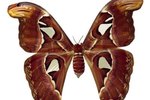
More than 350,000 species of beetles are found in major habitats worldwide, with 340 species used for human consumption. While the wide range of documented species do not posses evolved stingers, there are beetles that bite humans on occasion. A bite from a beetle can cause extreme pain and blistering to the human body and skin.
Long-Horned Beetles
There are 20,000 species worldwide of long-horned beetles, belonging to the Cerambycidae family. Adult long-horned beetles grow to be over half an inch long. They are most recognizable for their lengthy antennae, which are three times longer than their bodies. They are known as pests, especially to firewood. They bore holes into dying or dead wood, making them natural recyclers. They also feed on leaves, fungi, roots, nectar, flowers and pollen. On occasion a long-horned beetle will bite a human, causing swelling and acute pain for up to 48 hours. The bite is not fatal to humans.
African Bombardier Beetles
Bombardier beetles possess a defense mechanism that releases liquid from their abdomen with an explosive sound. It produces boiling hot toxic liquid that, while non-toxic to humans, can irritate and burn the skin, causing it to feel like a bite or sting. There are more than 500 African bombardier species worldwide.
Stag Beetles
The stag beetle is part of the Lucanidae family, found in habitats throughout the world. They are large beetles that are dark brown with giant mandibles, creating a prehistoric look. Males have enlarged mandibles that they use to fight each other for possession of food and mates. Male mandibles are too weak to cause harm to humans; however, female mandibles are small and powerful and can inflict a strong, painful bite to humans.
Blister Beetles
Blister beetles belong to the Meloidae family, with 7,500 species worldwide. They have long, narrow bodies, about an inch long, and are solid black or dark grey with a yellow stripe. They frequently feed on crops and small gardens that contain alfalfa, tomatoes or beets. Blister beetles are attracted to light, especially on patios. This increases the potential of a human coming into contact with the beetle. When a bite occurs, the blister beetle releases cantharidin, a poisonous chemical that causes human skin to blister. The blistering of the skin disappears on it own over time. It's rare, but blister beetle bites can be fatal to humans if a person experiences a severe allergic reaction.
References
Resources
Photo Credits
-
Stockbyte/Stockbyte/Getty Images
Writer Bio
Based in Miami, Shellie Alyssa has been writing articles since 2011. Her articles have appeared on a variety of popular and informative pet websites including munch.zone. In 2000, she was awarded an editors choice award for Outstanding Achievement in Poetry from the International Library of Poetry. She holds a fashion merchandising diploma from Penn Foster College.




